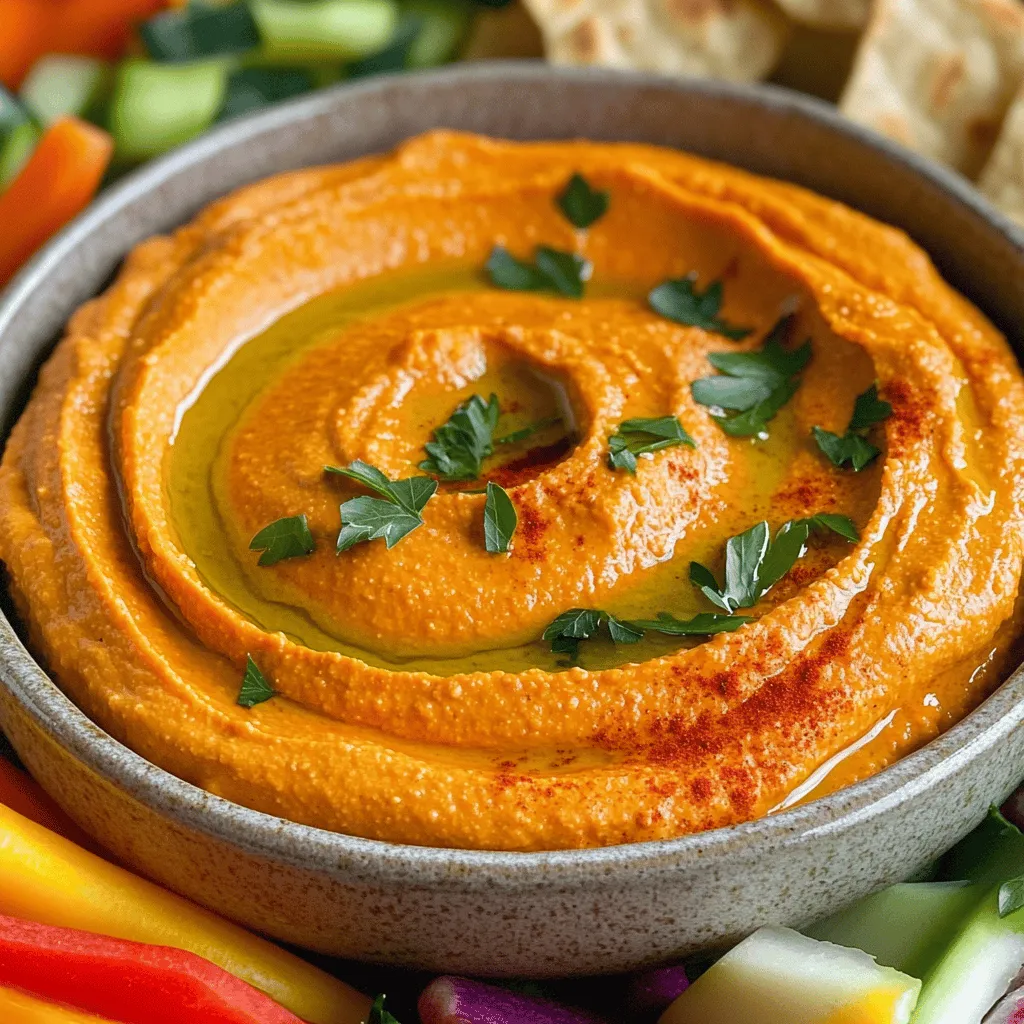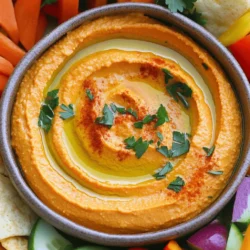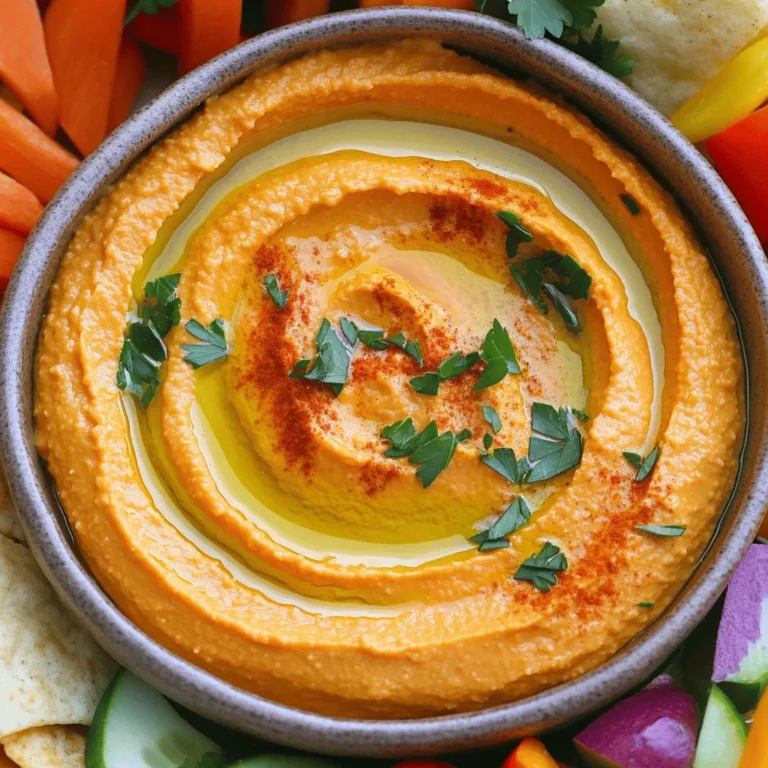Are you ready to spice up your snacking routine? This Vegan Roasted Red Pepper Hummus is not only simple to make but also packed with flavor. In just a few easy steps, you can create a tasty dip that impresses your friends and family. Plus, it offers great health benefits with fresh ingredients. Let’s dive into the delicious world of hummus and elevate your appetizer game!
Ingredients
List of Ingredients
To make this tasty vegan roasted red pepper hummus, you will need:
– 1 cup canned chickpeas, drained and rinsed
– 1 large roasted red pepper, peeled and chopped (store-bought or homemade)
– 3 tablespoons tahini
– 2 tablespoons olive oil
– 1 garlic clove, minced
– 2 tablespoons lemon juice
– 1 teaspoon smoked paprika
– 1/2 teaspoon ground cumin
– Salt and pepper to taste
– Water as needed for consistency
– Fresh parsley for garnish
– Extra olive oil for drizzling
Nutritional Information
This hummus packs a punch in terms of nutrition. Each serving provides:
– Calories: About 150
– Protein: 5 grams
– Carbohydrates: 12 grams
– Fiber: 4 grams
– Healthy fats: 8 grams
Health Benefits of Ingredients
Each ingredient in this hummus brings health benefits:
– Chickpeas: They are high in protein and fiber. They help keep you full longer.
– Roasted Red Peppers: These add vitamins A and C, boosting your immune system.
– Tahini: This sesame paste offers healthy fats and calcium.
– Olive Oil: It contains antioxidants and promotes heart health.
– Garlic: Garlic is known to support heart health and has anti-inflammatory properties.
– Lemon Juice: This adds vitamin C and can aid in digestion.
Using these fresh ingredients, you can enjoy a dip that tastes great and is good for you. Try this recipe for a healthy snack or appetizer.
Step-by-Step Instructions
Preparation of Ingredients
To start, gather your ingredients. If using fresh red peppers, roast them first. You can place them over an open flame or bake them in the oven. Roast until the skin is charred. This gives a smoky flavor. After roasting, let them cool. Then, peel off the skin and remove the seeds. If you prefer, you can also use jarred roasted red peppers. They save time and taste great.
Blending Process
Next, it’s time to blend! In a food processor, add the drained chickpeas, chopped roasted red pepper, tahini, minced garlic, lemon juice, smoked paprika, and ground cumin. Pulse these ingredients together. While the processor runs, slowly add the olive oil. This helps emulsify the mixture. Keep blending until it becomes smooth and creamy.
Adjusting and Seasoning
Now, you need to adjust the hummus. If it’s too thick, add water, one tablespoon at a time. Blend after each addition until you reach your desired consistency. Taste the hummus. Add salt and pepper based on your preference. Blend again to mix the seasoning well. Enjoy the rich flavors of your vegan roasted red pepper hummus!
Tips & Tricks
Best Methods for Roasting Peppers
Roasting peppers brings out their sweet, smoky flavor. You can roast them in a few easy ways:
– Over an Open Flame: Place the pepper directly on the flame of your gas stove. Turn it until the skin chars and blisters.
– In the Oven: Preheat your oven to 450°F (232°C). Place the peppers on a baking sheet and roast for about 20-30 minutes, turning halfway.
– Under the Broiler: Set your oven to broil. Place the peppers on a baking sheet and broil until the skin is charred.
After roasting, let the peppers cool. This makes peeling easier. You want to remove the skin and seeds for the best hummus.
Achieving Optimal Hummus Consistency
The perfect hummus has a creamy, smooth texture. To get this:
– Start with drained and rinsed canned chickpeas. This saves time and helps keep the hummus smooth.
– Add tahini, olive oil, garlic, and lemon juice to your food processor first.
– Blend these ingredients before adding chickpeas. This helps create a silky base.
– Gradually add water to adjust the texture. Blend until it’s smooth. If it’s too thick, add more water a little at a time.
Taste your hummus. If it needs salt or pepper, blend again to mix it in well.
Creative Serving Suggestions
Serving hummus can be fun and tasty! Here are some ideas:
– Serve with fresh vegetables like carrots, cucumbers, and bell peppers. They add crunch and color.
– Use pita chips or whole-grain crackers for dipping. They complement the flavors well.
– Drizzle extra olive oil on top before serving. This adds flavor and makes it look pretty.
– Garnish with fresh parsley or a sprinkle of smoked paprika for a touch of color.
With these tips, you can make your Vegan Roasted Red Pepper Hummus even better.

Variations
Spicy Roasted Red Pepper Hummus
You can kick up the heat with spicy roasted red pepper hummus. Add one to two jalapeños to the blender. This gives a nice kick without overpowering the flavor. You can also mix in some cayenne pepper or chili powder. Adjust the spice level to your taste.
Herb-Infused Versions
Herbs can add fresh notes to the hummus. Try mixing in fresh basil, cilantro, or dill. Just a handful will do. Blend these herbs right in for a burst of flavor. You can also use dried herbs like oregano or thyme for a different twist. This can brighten the dip and make it more vibrant.
Additional Flavor Enhancements
Want to get creative? You can add roasted garlic for a deeper flavor. Just roast a few cloves until soft, then blend them in. Another great option is to add a splash of balsamic vinegar. This adds a tangy note that pairs well with the sweetness of red peppers. Don’t forget to try adding a bit of lemon zest for extra brightness.
By exploring these variations, you can make your hummus unique each time. Find what you love best!
Storage Info
Best Practices for Storage
To keep your vegan roasted red pepper hummus fresh, store it in an airtight container. Glass containers work best. Make sure to press a piece of plastic wrap directly onto the surface of the hummus. This helps prevent it from drying out. If you make a large batch, divide it into smaller containers. This way, you can enjoy fresh hummus without exposing the whole batch to air.
How Long Does It Last?
When stored properly, your hummus can last up to one week in the fridge. Always check for any signs of spoilage before eating. If you see any mold or if it smells off, it’s best to toss it. I find that it’s often best within the first few days, when the flavors are fresh and vibrant.
Reheating and Chilling Tips
You don’t need to heat hummus, as it’s best served cold or at room temperature. However, if you prefer it warm, place it in a microwave-safe dish. Heat it gently in short bursts, stirring in between. If you chill it, take it out of the fridge about 15 minutes before serving. This helps the flavors come alive again. For a fun twist, serve it with warm pita or veggies right after chilling.Enjoy your dip!
FAQs
Can I make this hummus gluten-free?
Yes, this hummus is naturally gluten-free! You can enjoy it with gluten-free crackers or fresh veggies. Just check the labels of any dippers you use, like pita chips or bread. Most ingredients in this recipe are gluten-free, making it a safe choice for those avoiding gluten.
How do I make homemade roasted red peppers?
Making roasted red peppers at home is easy! Start by washing and drying your peppers. You can roast them in the oven or over an open flame.
1. For oven roasting, preheat your oven to 450°F (232°C). Place the peppers on a baking sheet.
2. Roast for 20-30 minutes until the skin is blackened and blistered.
3. Turn them halfway to roast evenly.
4. Once done, take them out and let them cool in a bowl. Cover it with plastic wrap.
5. After about 15 minutes, the steam helps loosen the skins.
6. Peel off the skins, remove the seeds, and chop them for your hummus.
Can I substitute tahini with another ingredient?
Yes, you can substitute tahini! If you need an alternative, try using peanut butter or sunflower seed butter. Both will add a nice creaminess. You can also use Greek yogurt for a tangy flavor, but it won’t be vegan. Adjust the amount based on your taste. Experiment to find what you like best!
This blog post covered all you need for making delicious roasted red pepper hummus. You learned about key ingredients, their health benefits, and how to prepare them well. We discussed tips for achieving the best texture and tasty variations. Finally, I shared best practices for storing and reheating your hummus.
In conclusion, you now have the tools to create a tasty, healthy snack. Enjoy exploring your own hummus recipes!


